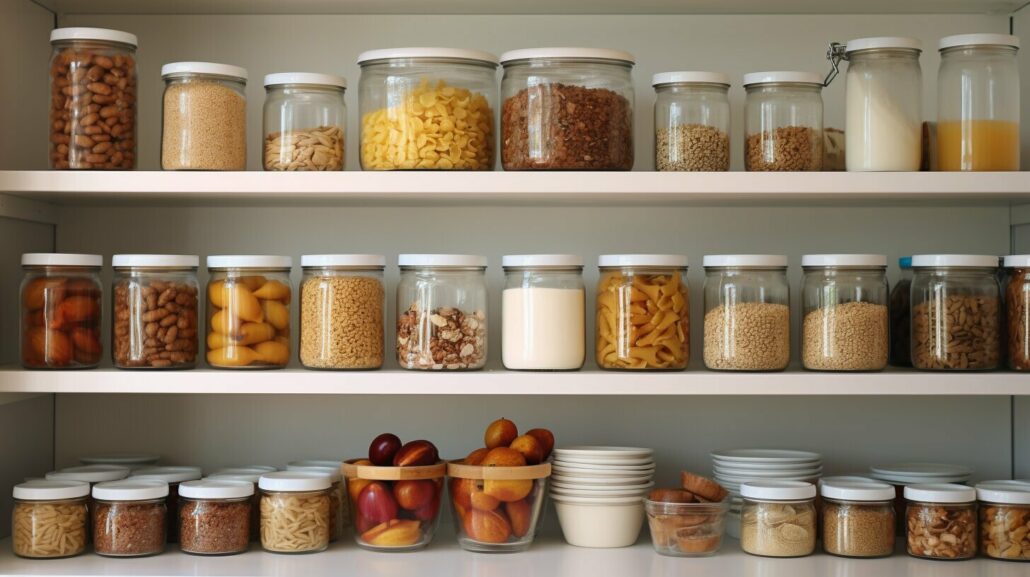Are you wondering if you should be doomsday prepping? In this beginner’s guide, we’ll explore all you need to know about prepping for disasters, equipping you with the knowledge and confidence to prepare for any eventuality.
Key Takeaways:
- Prepping is about reducing the chances of major life disruptions and being better prepared to recover from them.
- It doesn’t have to involve extreme measures; even simple preparations can make a difference.
- Start by building a solid personal finance and health foundation.
- Get your home ready for self-reliance by securing it and ensuring access to essential resources.
- Prepare to leave your home with a bug out bag and have everyday carry and get home bags for situations when you are away.
- Learn and practice core survival skills to enhance your preparedness.
- Share your knowledge and resources with others to create a strong community of prepared individuals.
- Prioritize and prepare for likely scenarios based on your specific risks.
- Have at least two weeks’ worth of supplies at home and three days’ worth in your car.
- Ensure your finances are in order and create an emergency fund.
- Develop a comprehensive prepping strategy to be well-prepared for potential doomsday scenarios.
Why Prepping Matters: Understanding the Importance of Emergency Preparedness
Prepping for disaster is not about succumbing to fear; it’s about taking control of your future and being better equipped to handle unforeseen challenges. Understanding the importance of emergency preparedness is crucial for safeguarding yourself and your loved ones.
When we talk about prepping, we’re referring to the proactive measures you can take to prepare for potential emergencies such as natural disasters, economic decline, or power outages. These events can disrupt our lives in significant ways, and having a plan in place can make all the difference in our ability to navigate and recover from them.
Prepping is not about fear-mongering or doomsday scenarios. It’s about being realistic and proactive. By taking steps to prepare, we can minimize the impact of emergencies, reduce stress, and increase our resilience. Prepping is not an extreme lifestyle; it’s a sensible approach to safeguarding ourselves and our loved ones.
So why does prepping matter? The answer is simple: it empowers us. It gives us the tools and resources we need to weather the storm, both figuratively and literally. By being prepared, we can confidently face whatever challenges come our way, knowing that we have taken the necessary steps to protect ourselves and our families.
Understanding the Risks and Taking Action
When it comes to emergency preparedness, knowledge is power. Understanding the potential risks in your area and taking action to mitigate them is a crucial part of prepping. Whether it’s having an emergency kit stocked with essential supplies or developing a communication plan with your family, every step you take brings you closer to being ready for the unexpected.
Preparing for disasters is a collective effort. By working together as a community, we can strengthen our resilience and support one another in times of crisis. Sharing knowledge, exchanging resources, and building a network of support are all integral parts of the prepping journey.
| Key Prepping Steps | Benefits |
|---|---|
| Building a solid personal finance and health foundation | Ensures financial stability and physical well-being |
| Getting your home ready for self-reliance | Provides a safe and sustainable shelter during emergencies |
| Preparing to leave your home with a bug out bag | Allows for quick evacuation with essential supplies |
| Having everyday carry and get home bags | Enables preparedness on the go and during daily activities |
| Learning and practicing core survival skills | Enhances self-sufficiency and ability to handle emergencies |
| Sharing prepping knowledge with others | Strengthens community preparedness and fosters support |
| Tailoring prepping strategy to likely scenarios | Focuses efforts on the most probable events |
Remember, it’s essential to prioritize your prepping efforts based on your specific risks. Start by ensuring you have at least two weeks’ worth of supplies at home and three days’ worth in your car. Additionally, make sure your finances are in order and create an emergency fund. Developing a comprehensive plan and considering different scenarios will help ensure you’re well-prepared for whatever challenges may come your way.
Prepping is not about living in fear; it’s about living with confidence. By taking the time to prepare now, we can create a brighter and more secure future for ourselves and our loved ones. Start your prepping journey today and empower yourself to face any emergency with resilience and strength.
Simple Steps to Start Prepping: Building a Solid Foundation
Embarking on your prepping journey doesn’t have to be overwhelming. By following simple steps and focusing on building a solid foundation, you can ensure you are adequately prepared for any potential disaster.
First and foremost, it’s important to take stock of your personal finance and health. These two aspects form the core of your prepping foundation. Start by creating an emergency fund to cover unexpected expenses. Aim to save at least three to six months’ worth of living expenses. This will provide a financial safety net during times of crisis. Additionally, prioritize your health by maintaining a well-balanced diet, exercising regularly, and staying up to date with medical check-ups. Good physical and mental health will enhance your overall resilience and ability to cope with challenging situations.
Next, focus on getting your home ready for self-reliance. Ensure you have essential supplies such as food, water, and basic medical supplies stocked up. Create an emergency kit that includes items like flashlights, batteries, a first aid kit, and a portable radio. It’s also important to secure your home by reinforcing doors and windows, installing smoke detectors and carbon monoxide detectors, and having a fire extinguisher readily available. By taking these simple steps, you can enhance the safety and comfort of your living environment during emergencies.
In addition to preparing your home, it’s crucial to have a bug out bag ready in case you need to evacuate. A bug out bag is a portable kit that contains essential items for survival on the go. It should include items such as food, water, a multi-tool, a first aid kit, clothing, and important documents. Keep your bug out bag easily accessible and regularly update its contents to ensure they are current and meet your specific needs.
“Prepping isn’t just about surviving; it’s about thriving in challenging times.”
Building a solid prepping foundation involves more than just physical preparations. It’s important to invest time in learning and practicing core skills that will enhance your overall preparedness. These skills include first aid, navigation, fire-starting, and self-defense. Take advantage of online resources, community workshops, and local organizations that offer training in these areas. By continually honing your skills, you will develop the confidence and competence to navigate through difficult situations.
Lastly, don’t overlook the power of community. Share your knowledge and resources with others. Building a strong network of like-minded individuals can provide support and aid in times of need. Consider joining local prepping groups or online forums to connect with others who share your interests. Together, we can strengthen our collective preparedness and face any challenges that come our way.
| Prepping Essentials Checklist: |
|---|
| Create an emergency fund to cover unexpected expenses |
| Maintain good physical and mental health |
| Stock up on essential supplies for your home |
| Secure your home and have emergency tools readily available |
| Prepare a bug out bag for evacuation |
| Invest time in learning and practicing core survival skills |
| Connect with like-minded individuals and build a supportive community |
Embarking on a prepping journey is a proactive approach to safeguarding yourself and your loved ones. Remember, prepping isn’t just about surviving; it’s about thriving in challenging times. By following these simple steps and building a solid foundation, you can face any potential disaster with confidence and preparedness.
Getting Your Home Ready: Self-Reliance and Safety Measures
Your home is your sanctuary, and it’s crucial to make it a safe and self-reliant place during times of crisis. Taking steps to get your home ready can significantly enhance your preparedness and peace of mind. Here are some prepping tips to help you get started:
- Secure your home: Strengthen the security of your home by installing sturdy locks, reinforcing doors and windows, and considering a home security system. This will not only deter potential intruders but also provide you with a sense of safety.
- Ensure access to essential resources: In case of power outages or disruptions in the water supply, it’s important to have alternative sources of these essential resources. Consider investing in a backup generator, storing extra water, and learning how to purify water for long-term use.
- Stock up on supplies: Create a well-stocked pantry with non-perishable food items, including canned goods, dry goods, and meals ready to eat. Don’t forget to regularly rotate and update the supplies to ensure freshness.
- Implement safety measures: Install smoke detectors, carbon monoxide detectors, and fire extinguishers in key areas of your home. Familiarize yourself with their usage and conduct regular maintenance checks to ensure they are in working condition.
- Create a communication plan: Establish a communication plan with your family members or neighbors to stay connected during emergencies. This can include designated meeting places, emergency contact numbers, and a backup communication method, such as walkie-talkies or a satellite phone.
By taking these steps, you’ll be better prepared to handle emergencies and ensure the safety and well-being of yourself and your loved ones. Remember, prepping is an ongoing process, so regularly review and update your emergency supplies and plans to stay prepared for any situation.
Table: Essential Supplies for Home Prepping
| Category | Supplies |
|---|---|
| Food | Canned goods, dry goods, MREs |
| Water | Bottled water, water purification tablets |
| First Aid | First aid kit, medications, bandages |
| Lighting | Flashlights, batteries, candles |
| Communication | Cell phone, walkie-talkies, backup batteries |
| Tools | Multi-tool, duct tape, rope |
| Sanitation | Hand sanitizer, toilet paper, hygiene products |
| Shelter | Tents, sleeping bags, blankets |
| Protection | Face masks, gloves, self-defense tools |
| Documentation | Important documents, cash, copies of IDs |
Remember, getting your home ready is just one aspect of prepping. Be sure to explore other areas, such as creating bug out bags and learning essential survival skills. By taking a comprehensive approach to prepping, you’ll be well-equipped to handle any emergency that comes your way.
Bug Out Bag: Preparing to Leave Your Home
In certain disaster scenarios, leaving your home might become necessary, and having a well-prepared bug out bag can make all the difference. Let’s delve into what a bug out bag is and what essentials it should contain.
A bug out bag, also known as a go bag or an emergency kit, is a portable collection of essential items that you can grab quickly when you need to evacuate your home. It’s important to have a bug out bag ready in case of emergencies like natural disasters, civil unrest, or any situation that requires you to leave your home quickly and survive for an extended period.
To ensure your bug out bag is effective, it’s crucial to include the right essentials. Here’s a list of prepping essentials that should be in your bug out bag:
- Water and water purification methods
- Non-perishable food items
- A first aid kit
- Basic tools like a multi-tool, knife, and duct tape
- Emergency shelter like a tent or tarp
- Fire-starting tools such as waterproof matches or a lighter
- Flashlight and extra batteries
- Extra clothing and sturdy footwear
- Personal hygiene items and medications
- Important documents (copies) and some cash
| Item | Quantity |
|---|---|
| Water | 3 liters/person |
| Non-perishable food | 3 days’ supply |
| First aid kit | 1 |
| Multi-tool | 1 |
Remember to personalize your bug out bag based on your individual needs and circumstances. Consider factors such as climate, geographic location, and the specific risks you might face. Regularly review and update your bug out bag to ensure that the items inside remain in good condition and meet your evolving needs.
Everyday Carry and Get Home Bags: Preparedness on the Go
Being prepared doesn’t just apply to your home; it’s also crucial to have the necessary supplies and resources with you wherever you go. Explore the importance of everyday carry and get home bags in ensuring you’re prepared on the go.
When an emergency strikes, you may not always have the luxury of being in the comfort and safety of your own home. Whether it’s a sudden evacuation or finding yourself stranded away from home, having the right gear can make all the difference. That’s where everyday carry (EDC) and get home bags come in.
An everyday carry bag is a compact kit that you carry with you at all times, providing you with essential items for daily emergencies. It can include items like a multitool, flashlight, first aid supplies, a portable charger, and other items that you may find useful in your day-to-day life. Having these tools readily available ensures that you’re prepared for any unexpected situation that may arise while you’re out and about.
| Essential Items for Everyday Carry Bags | Get Home Bags |
|---|---|
| Flashlight | Map and compass |
| Multi-tool | Water bottle |
| First aid supplies | Snacks and energy bars |
| Portable charger | Emergency cash |
| Emergency contact information | Change of clothes |
Having a well-equipped everyday carry bag can give you peace of mind knowing that you’re prepared for unexpected situations while you’re away from home.
On the other hand, a get home bag is a larger backpack or duffel bag containing supplies that would help you survive and make your way back home during an emergency situation. This could include items like a map and compass, a water bottle, snacks and energy bars, emergency cash, and a change of clothes. Get home bags are especially useful if you find yourself far away from home when disaster strikes and need to navigate unfamiliar terrain.
Remember that the contents of your everyday carry and get home bags should be tailored to your specific needs and the potential emergencies you may encounter. Regularly review and update your bags to ensure that the supplies are still in good condition and meet your current requirements.
Summary:
- Everyday carry and get home bags are essential for being prepared on the go.
- Everyday carry bags contain essential items for daily emergencies.
- Get home bags are larger backpacks or duffel bags with supplies to help you make your way back home during an emergency.
- Tailor the contents of your bags to suit your specific needs and potential emergencies.
Having a well-equipped everyday carry bag and a thoughtfully packed get home bag can give you peace of mind, knowing that you’re prepared for unexpected situations while you’re away from home.
Learning and Practicing Core Skills: Investing in Survival Knowledge
Building your prepping skills repertoire is as crucial as having the right supplies. Let’s delve into the core skills that can significantly enhance your chances of survival and resilience during emergencies.
First Aid
When disaster strikes, knowing basic first aid can make a world of difference. From treating minor injuries to providing life-saving interventions, first aid skills can help you and others in times of crisis. Consider taking a certified first aid course to learn proper techniques and gain confidence in your ability to respond effectively.
Navigation
Being able to navigate through unfamiliar terrain is essential during emergencies. Whether it’s using a map and compass or knowing how to interpret natural landmarks, honing your navigation skills can help you find your way to safety. Practice orienteering or participate in outdoor navigation courses to improve your abilities.
Fire-starting
Fire is not only a source of warmth but also a means to cook food, purify water, and signal for help. Learning different fire-starting techniques, such as using flint and steel, fire strikers, or even primitive methods, can ensure you have the means to create fire when needed. Experiment with different methods in controlled environments to develop proficiency.
Self-Defense
During uncertain times, knowing how to defend yourself can be crucial. Learning self-defense techniques can enhance your personal safety and provide a sense of empowerment. Consider enrolling in self-defense classes or practicing martial arts to develop the skills needed to protect yourself and your loved ones.
| Skills | Benefits |
|---|---|
| First Aid | Provides life-saving interventions in emergencies. |
| Navigation | Ensures you can find your way to safety. |
| Fire-starting | Creates a source of warmth, cooking, and signaling for help. |
| Self-Defense | Enhances personal safety and empowerment. |
Building a comprehensive prepping strategy involves not only gathering supplies but also acquiring and practicing core survival skills. First aid, navigation, fire-starting, and self-defense are just a few examples of skills that can greatly contribute to your preparedness. Remember to practice these skills regularly to maintain proficiency and stay ready for any emergencies that may come your way.
Sharing Prepping Knowledge: Strengthening Community Preparedness
Preparedness is not just an individual endeavor; it’s about fostering a sense of community resilience. Learn the importance of sharing your prepping knowledge and resources with others, and together, we can build a stronger and more prepared society.
When it comes to prepping, sharing knowledge with others can have a significant impact on our collective preparedness. By sharing what we have learned and experienced, we can help others avoid common mistakes and make more informed decisions about their own emergency plans. It’s not just about survival; it’s about equipping our communities with the tools and skills needed to thrive during challenging times.
Benefits of Sharing Prepping Knowledge
There are several benefits to sharing prepping knowledge with others. First and foremost, it creates a sense of unity and support within our communities. When we collaborate and work together, we can pool our resources and expertise, making us more resilient and better prepared to face any potential challenges that may arise.
“Alone we can do so little; together we can do so much.” – Helen Keller
In addition to building a stronger community, sharing prepping knowledge also helps to spread awareness about the importance of emergency preparedness. Many people may not realize the potential risks they face or understand the steps they can take to mitigate those risks. By sharing our knowledge, we can empower others to take action and start their own preparedness journey.
How to Share Your Prepping Knowledge
Sharing your prepping knowledge doesn’t have to be complicated. Start by engaging with your friends, family, and neighbors. Organize community workshops or meetups where you can discuss different aspects of prepping, such as food storage, first aid, or communication strategies during emergencies. You can also share helpful resources, like books, websites, or YouTube channels, that provide valuable information on prepping essentials.
| Ways to Share Prepping Knowledge | Benefits |
|---|---|
| Organize community workshops or meetups | Encourages discussion and collaboration among community members. |
| Create a neighborhood prepping group | Allows for ongoing support and the sharing of resources. |
| Share helpful online resources and articles | Provides easy access to prepping information for others. |
Remember, the goal is not to instill fear, but rather to empower and educate. Approach sharing your prepping knowledge with empathy and understanding, recognizing that everyone’s journey will be unique. Together, we can create a more prepared and resilient society, one community at a time.
Prioritizing and Preparing for Likely Scenarios: Tailoring Your Prepping Strategy
When it comes to prepping, a one-size-fits-all approach doesn’t work. By prioritizing and preparing for likely scenarios, you can tailor your prepping strategy and be better prepared for the challenges that lie ahead.
Start by assessing your specific risks and focusing on the most probable events. Consider factors such as your geographical location, climate, and the types of disasters that are more prevalent in your area. This will help you determine which scenarios to prioritize and allocate your resources accordingly.
As you prioritize, it’s important to start small and build from there. Begin by having at least two weeks’ worth of supplies at home and three days’ worth in your car. Stock up on non-perishable food, clean water, medications, and other essential items. Don’t forget to rotate your supplies regularly to ensure freshness.
In addition to physical preparedness, financial readiness is crucial. Make sure your budgets are in order, and consider creating an emergency fund to cover unexpected expenses. It’s also wise to have copies of important documents, such as identification papers, insurance policies, and personal records, stored securely in a waterproof container.
Lastly, it’s essential to develop a comprehensive plan that covers different scenarios. Consider factors such as communication plans, evacuation routes, and meeting points for family members. Regularly review and update your plan to account for any changes in circumstances.
By tailoring your prepping strategy to address the most likely scenarios, you can achieve a higher level of preparedness and peace of mind. Remember, prepping is an ongoing process, so continue to learn, practice, and share your knowledge with others. Together, we can all be better equipped to face whatever challenges come our way.
FAQ
Q: Should I be doomsday prepping?
A: Doomsday prepping is about being prepared for potential emergencies such as natural disasters, economic decline, or power outages. It’s important to start prepping now to reduce the chances of major life disruptions and be better prepared to recover from them.
Q: Why is prepping important?
A: Prepping is important because it allows you to be prepared for potential emergencies, such as natural disasters or power outages. By taking simple steps like having essential supplies and equipment readily available, you can increase your chances of staying safe and secure during difficult times.
Q: What are the simple steps to start prepping?
A: The basic steps to start prepping include building a solid personal finance and health foundation, getting your home ready for self-reliance, preparing to leave your home with a bug out bag, having everyday carry and get home bags, learning and practicing core skills, and sharing your knowledge with others.
Q: How can I get my home ready for self-reliance?
A: Getting your home ready for self-reliance involves securing your home, ensuring access to essential resources like water and food, and implementing safety measures to protect yourself and your loved ones during emergencies.
Q: What is a bug out bag and why is it important?
A: A bug out bag is a portable kit that contains essential supplies to sustain you for at least 72 hours during an emergency situation. It is important because it allows you to quickly leave your home with necessary supplies in case of evacuation.
Q: What should I include in my everyday carry and get home bags?
A: Your everyday carry and get home bags should include essential items such as water, food, a first aid kit, a flashlight, a multi-tool, a map, a compass, and any other necessities you might need while away from home.
Q: What core skills should I learn for prepping?
A: Core skills for prepping include first aid, navigation, fire-starting, and self-defense. Learning and practicing these skills will enhance your ability to survive and thrive during emergencies.
Q: Why is sharing prepping knowledge important?
A: Sharing prepping knowledge is important because it helps to strengthen community preparedness. By sharing your expertise and resources, you can help others become better prepared for emergencies, creating a more resilient community.
Q: How do I prioritize and prepare for likely scenarios?
A: Prioritizing and preparing for likely scenarios involves assessing your specific risks and focusing on preparing for the most probable events. It’s important to tailor your prepping strategy based on your specific circumstances and the 80% of likely scenarios.










